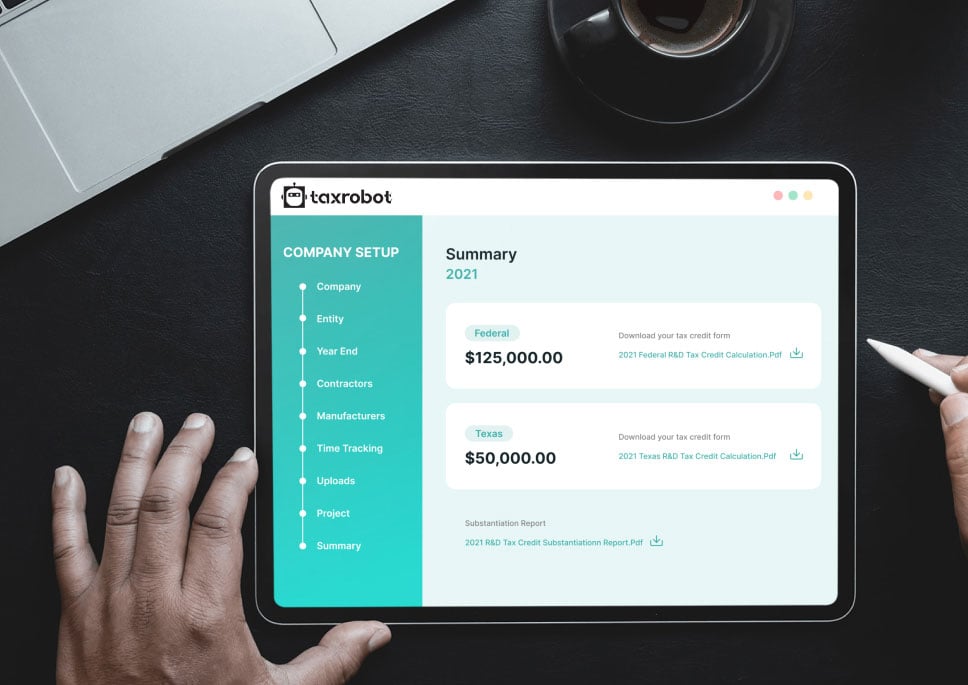Michigan R&D Credit
Maximize your State Credits today!
Put the R&D tax credit process on autopilot.
Trusted By:








Michigan R&D Credit
Discover your eligibility for Michigan R&D tax credits and supercharge your enterprise.
Are there R&D tax credits for Michigan?
Yes, there are R&D tax credits for Michigan, including both state and federal credits. However, this specific Michigan tax credit is subject to specific rules and guidelines, making it quite different from most other state R&D tax credits.
Michigan R&D Tax Credit
In the past, Michigan had an R&D tax credit. However, it was only applicable to certain years and went away for a while. Now, the credit is back for the foreseeable future. There is even the possibility it will expand in the future.
Currently, the Michigan tax credit allows companies to receive a credit based on how much they have invested in research and development activities. This credit is meant to encourage investment and development within the state. These activities must have taken place in Michigan to qualify for the credit. If a company is based in Michigan but conducts its research and development elsewhere, the expenses spent on that research and development do not help with the Michigan R&D tax credit.
Outside of this main restriction, the restrictions placed on qualifying activities are similar to those in the federal tax credit.
Federal R&D Tax Credit
The federal R&D tax credit is available alongside the Michigan R&D tax credit. This credit is a straightforward credit that rewards businesses for conducting research and development activities. This credit can provide a reduction of anywhere between 6% to 8% of a company’s qualifying research expenses.
How Much Could You Save?
In Michigan, the tax credit can be up to 1.9% of the qualified research expenses conducted in Michigan during the tax year. The credit has an upper limit but still gives plenty of opportunity for savings.
The R&D credit exists alongside two other credits specific to Michigan, all of which impact a company’s tax basis. These are the investment tax credit and the compensation credit. This is important to note because these credits together have an impact on one another. Specifically, when combined, the credits cannot exceed 75% of the taxpayer’s tax liability in a given year. So, companies applying for multiple credits need to be aware of how the amount of each credit impacts the other credits.
Which Businesses Qualify?
Plenty of different businesses qualify for the Michigan R&D tax credit. These include:
- C-Corporations
- S-Corporations
- LLCs
- Partnerships
Which Expenses Qualify?
Not everything that a company spends on research and development automatically qualifies for this tax credit. Many activities will end up being qualified research expenses, but some will not. Because of this, it is important to note which activities qualify and which do not.
Qualifying expenses are held to these four restrictions:
- Improvement: The research and development that is accomplished must improve something existing or develop one. This could be a physical product the company is working on or a service or process they offer. Any funds allocated toward this improvement qualify.
- Technological: The research must be technological in nature.
- Eliminate uncertainty: Uncertainty exists when dealing with any sort of business practice. Putting funds toward eliminating some form of uncertainty allows them to qualify for this credit.
- Experimentation: The research and development that is conducted can’t be completely haphazard. Some form of logical experimentation is necessary.
How to Make Claiming the R&D Tax Credit Easier
The Michigan R&D tax credit is claimed on Form 4570, Part 4, when filing taxes. Overviewing the information here and comparing it to current research expenses is a great place to start when it comes to actually claiming this credit. Doing so ensures that you know and understand the information behind it. With some automated accounting software like TaxRobot, this is even easier. We can make sure you claim all of the R&D credit you are eligible for. Plus, we handle the documentation and other logistics that can become overwhelming.
It is also important to note that this claim is filed alongside Michigan tax returns. This makes it easy to remember when to file.
See How Much You Could Save
Wondering just how much you could shave off your tax bill with the R&D tax credit? Use our calculator to get an estimate.
Take a sneak peak

- Limited Time Offer
- Simple Onboarding
- Easy to Use
R&D Tax Credits FAQs
The four-part test as outlined in the Internal Revenue Code is used to determine qualified R&D activity.
The Four-Part Test
1). New Or Improved Business Component
Creation of a new product, process, formula, invention, software, or technique; or improving the performance, functionality, quality, or reliability of existing business component.
- Construction of new buildings or renovation of existing buildings
- Invention of a software application
- Manufacturing of a new product or the improvement of the production process for an existing product
- Creation of design documentation
2). Technological In Nature
The activity fundamentally relies on principles of the physical or biological sciences, engineering, or computer science. A taxpayer does not need to obtain information that exceeds, expands or refines the common knowledge of skilled professionals in a particular field.
- Physics (relationship between mass, density and volume; loading as the
result of gravitational attraction) - Engineering (mechanical, electrical, civil, chemical)
- Computer science (theory of computation and design of computational systems)
3). Elimination Of Uncertainty
Uncertainty exists if the information available to the taxpayer does not establish the capability or method for developing or improving the business component, or the appropriate design of the business component.
- The capability of a manufacturer to create a part within the specified tolerances
- The appropriate method of overcoming unsuitable soil conditions during construction
- The appropriate software design to meet quality and volatility requirements
4). Process Of Experimentation
A process designed to evaluate one or more alternatives to achieve a result where the capability or method of achieving that result, or the appropriate design of that result, is uncertain as of the beginning of the taxpayer’s research activities.
- Systematic process of trial and error
- Evaluating alternative means and methods
- Computer modeling or simulation Prototyping Testing
The R&D tax credit is one of the most misunderstood tax incentives available. Considering the myriad of industries and activities that legally qualify for the credit, the term “research and development” is a misnomer. Additionally, the R&D tax credit requires specialized knowledge and technology to identify and calculate the incentive properly.
Companies of various industries are unaware that they are eligible to claim the R&D tax credit. Under the Internal Revenue Code’s definition of R&D, many common activities qualify. You can get tax benefits for industries including software, technology, architecture, engineering, construction, manufacturing, and more.
The R&D tax credit can be claimed for all open tax years. Generally, open tax years include the prior three tax years due to the statute of limitations period. In certain circumstances, the law allows businesses to claim the R&D tax credit for an extended period of time. It is common for companies to amend previous tax years to claim this benefit and reduce the maximum amount of tax liability.
Partnerships and S corporations must file this form to claim the credit. The credit will flow from the Form 6765, to the Schedule K-1, to the Form 3800 on the individual’s tax return. For individuals receiving this credit that have ownership interest in a partnership or S corporation, Form 6765 is not required on the individual return.
Individuals claiming this credit can report the credit directly on Form 3800, General Business Credit if their only source for the credit is a partnership, S corporation, estate, or trust. Otherwise, Form 6765 must be filed with the individual’s tax return (e.g. sole proprietorship).
For tax years prior to 2016, the credit can be used to reduce the taxpayer’s regular tax liability down to the tentative minimum tax. The credit cannot be used to offset alternative minimum tax. Beginning in tax year 2016, eligible small businesses have expanded utilization for the credit. For these eligible small businesses, the regular tax liability can offset alternative minimum tax using the “25/25” rule.
What our customers have to say
I highly recommend TaxRobot to anyone considering an R&D Tax Credit software to complete their analysis.

We decided to switch to TaxRobot… Best decision we’ve ever made. More affordable, and less complicated.

I couldn’t believe how easy it was! In under an hour, we saved enough money to hire a new employee.
